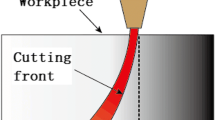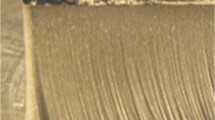Abstract
Abrasive water jet (AWJ) now is used as a precision cutting tool. With this tool, dimension tolerance less than 0.1 mm is expected in the cutting process. This dimension tolerance is enough for some applications. However, higher precision is necessary in order to use AWJ in some other applications. To get higher precision in an AWJ cutting process, controlling AWJ beam more accurately is needed, and this further leads to understanding AWJ cutting front more accurately. This paper compared the current cutting front profile exploration methods and then provided a new method to collect AWJ cutting front information accurately. With this new method, a better understanding of the cutting front profile is possible, which further leads to higher precision cutting of AWJ. This paper also demonstrated that the AWJ cutting front profile could be fitted by parabolic curves accurately.
Similar content being viewed by others
References
Henning A, Westkämper E (2006) Analysis of the cutting front in abrasive waterjet cutting. In Longman P (ed) Proceedings of the 18th international conference on water jetting, Gdansk, Poland, September 2006, p 425–434
Hashish M (1984) On the modeling of abrasive-waterjet cutting. In Watts GA, Stanbury JEA (eds) Proceedings of the 7th international symposium on jet cutting technology, June 26–28, Ottawa, Canada, p 249–265
Matsui S, Matsumura H, Ikemoto Y, Tsujita K, Shimizu H (1990) High precision cutting method for metallic materials by abrasive waterjet. In Saunders D (ed) Jet cutting technology—proceedings of the 10th international symposium, Amsterdam, The Netherlands, October 31–November 2, p 263–278
Zeng J, Heines R, Kim TJ (1991) Characterization of energy dissipation phenomenon in abrasive waterjet cutting. In: Proceedings of the 6th American waterjet conference, Houston, Texas, USA, p 163–177
Henning A, Goce R, Westkämper E (2002) Analysis and control of striation structures at the cutting edge of abrasive waterjet cutting. In: Lake P (ed) Proceedings of the 16th international conference on jetting technology, Aix-en-Provence, France, October 16–18, p 173–191
Hlaváˇca LM, Hlavácˇováa IM, Gembalováa L et al (2009) Experimental method for the investigation of the abrasive water jet cutting quality. J Mater Process Technol 209:6190–6195
Zeng J, Kim TJ, Wallace RJ (1992) Quantitative evaluation of machinability in abrasive waterjet machining, proceedings of the 1992 winter annual meeting of ASME, precision machining: technology and machine development and improvement, (PED-58):169–179, Anaheim
Author information
Authors and Affiliations
Corresponding author
Rights and permissions
About this article
Cite this article
Zhang, S., Wu, Y. & Wang, S. An exploration of an abrasive water jet cutting front profile. Int J Adv Manuf Technol 80, 1685–1688 (2015). https://doi.org/10.1007/s00170-015-7154-7
Received:
Accepted:
Published:
Issue Date:
DOI: https://doi.org/10.1007/s00170-015-7154-7




